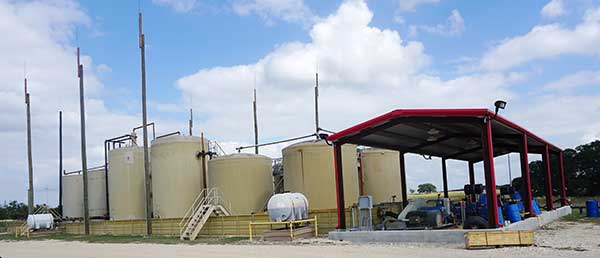
SPCC Plan Consulting Services Commercial Salt Water Disposal Facilities
What is an SPCC Plan for Commercial Salt Water Disposal Facilities?
The EPA Clean Water Act requires that any facility that has oil product storage capacities of 1,320 gallons or more develop and implement a Spill Prevention, Control and Countermeasure (SPCC) plan in accordance with 40 CFR Part 112.
Salt Water Disposal Facilities receive, usually by tank trucks, produced water/oil emulsion for separation and proper disposal. The facility includes an approved disposal well for salt water disposition. Any quantity of crude oil resulting from the separation process is stored in facility tanks for removal by tank trucks. As this pertains to Oil Salt Water Disposal facilities, their Produced Water and Oil, and Gun Barrel Separators vessels in addition to any other oil products storage that exceed 55 gallons in capacity is applicable and must be addressed in the plan. These storage tanks, referred to as a Tank Battery, in addition to equipment failures, are very susceptible to lightning strikes which may result in a major oil spill.
If the facility could reasonably expect an oil spill to reach navigable waters, an SPCC Plan is required. The Coast Guard interpretation includes not only the traditional navigable waters but all streams, ditches, storm sewers, rivers, lakes or other bodies of water.
SPCC Regulations
A properly compliant SPCC plan will cover all applicable regulations and include a detailed discussion of the following:
- A detail listing of all oil product vessels of 55 gallons or more.
- Provide secondary containment of sufficient length, breadth and height to contain 110% (for rainfall freeboard) of the total maximum capacity of the largest vessel within the facility to accommodate rainfall freeboard. The largest vessel may be the total volume of tanks permanently manifolded together. The secondary containment shall be constructed of earth, steel, concrete or solid masonry to be impervious to withstand a full hydrostatic head and be restricted to 6 feet above interior grade.
- For newly constructed facilities, the State of Texas is now requiring that the secondary containment be capable of containing 100% of the total vessel storage capacities.
- Topographical Maps showing distance to any waterways, intermittent streams or bodies of water.
- Diagram of facility detailing the location of all oil product storage vessels and the primary direction of drainage from the facility
- Reference to specific applicable EPA regulations
- An Oil Spill Contingency Plan detailing all actions to be taken in the event of a major oil spill and a Written Commitment of Manpower, Equipment and Materials signed by management.
- Employee training directives and applicable records
- Inspection and reporting forms
- Loading and Unloading areas’ spill catch sumps operation as well as general spill prevention procedures and equipment.
Have a Question?
SPCC Plan Expert
Maurice provides the lowest possible costs while maintaining the highest quality and compliance for his services in developing Spill Prevention, Control and Countermeasure (SPCC) Plans in the salt water disposal industry.
SPCC Plans Are Our Only Business
Spillco has provided several thousand SPCC plans in over 30 states for over 700 clients of various industries during the past 10 years. SPCC plans are our only business. We have contracted Professional Engineers who are knowledgeable of the SPCC requirements and are licensed in over 30 states.
Over fifty Commercial Salt Water Disposal facilities have had Spillco’s PE Certified SPCC Plans provided. We provide Certified SPCC plans for a fraction of the cost of our competitors. The reason is simple. Due to our experience, we developed systems for applications that do not require our time in researching and constructing a specific plan from the initial stage. The information from a facility is molded into our system for a site specific plan compliant with EPA, state and local applicable regulations.